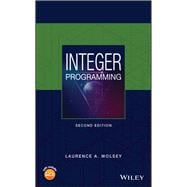A PRACTICAL GUIDE TO OPTIMIZATION PROBLEMS WITH DISCRETE OR INTEGER VARIABLES, REVISED AND UPDATED
The revised second edition of Integer Programming explains in clear and simple terms how to construct custom-made algorithms or use existing commercial software to obtain optimal or near-optimal solutions for a variety of real-world problems. The second edition also includes information on the remarkable progress in the development of mixed integer programming solvers in the 22 years since the first edition of the book appeared. The updated text includes information on the most recent developments in the field such as the much improved preprocessing/presolving and the many new ideas for primal heuristics included in the solvers. The result has been a speed-up of several orders of magnitude. The other major change reflected in the text is the widespread use of decomposition algorithms, in particular column generation (branch-(cut)-and-price) and Benders’ decomposition. The revised second edition:
- Contains new developments on column generation
- Offers a new chapter on Benders’ algorithm
- Includes expanded information on preprocessing, heuristics, and branch-and-cut
- Presents several basic and extended formulations, for example for fixed cost
- network flows
- Also touches on and briefly introduces topics such as non-bipartite matching, the complexity of extended formulations or a good linear program for the implementation of lift-and-project
Written for students of integer/mathematical programming in operations research, mathematics, engineering, or computer science, Integer Programming offers an updated edition of the basic text that reflects the most recent developments in the field.








